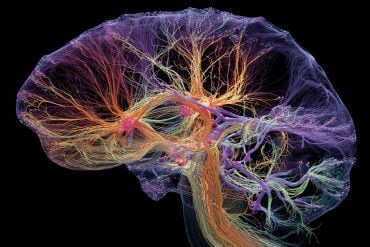Summary: Researchers have created a “molecular GPS” to guide immune cells directly to the brain, enabling precise targeting of tumors like glioblastoma. These cells use a unique protein code to navigate and attack cancer while sparing healthy tissue, offering a safer alternative to traditional treatments.
In mice, this technology successfully cleared tumors, prevented recurrences, and reduced brain inflammation in models of multiple sclerosis. The approach shows potential to revolutionize the treatment of hard-to-reach brain diseases.
Scientists aim to advance these engineered cells for human trials, which could help millions with cancer or neurological conditions. This innovation represents a significant step toward more effective, patient-specific therapies.
Key Facts:
- Immune cells use a protein “zip code” for the brain and a tumor-specific “address” to target cancer precisely.
- In mouse models, the cells eliminated glioblastoma and reduced inflammation in multiple sclerosis.
- This approach spares healthy tissues and offers a safer alternative to conventional brain cancer treatments.
Source: UCSF
UCSF scientists have developed a “molecular GPS” to guide immune cells into the brain and kill tumors without harming healthy tissue.
This living cell therapy can navigate through the body to a specific organ, addressing what has been a major limitation of CAR-T cancer therapies until now. The technology worked in mice and the researchers expect it to be tested in a clinical trial next year.

The scientists showed how the immune cells could eliminate a deadly brain tumor called glioblastoma and prevent recurrences. They also used the cells to tamp down inflammation in a mouse model of multiple sclerosis.
“Living cells, especially immune cells, are adapted to move around the body, sense where they are, and find their targets,” said Wendell Lim, PhD, UCSF professor of cellular and molecular pharmacology and co-senior author of the paper, which appears in Science on Dec. 5.
Navigating to the source of disease
Nearly 300,000 patients are diagnosed with brain cancers each year in the United States, and it is the leading cause of cancer mortality in children.
Brain cancers are among the hardest cancers to treat. Surgery and chemotherapy are risky, and drugs can’t always get into the brain.
To get around these problems, the scientists developed a “molecular GPS” for immune cells that guided them with a “zip code” for the brain and a “street address” for the tumor.
They found the ideal molecular zip code in a protein called brevican, which helps to form the jelly-like structure of the brain, and only appears there. For the street address, they used two proteins that are found on most brain cancers.
The scientists programmed the immune cells to attack only if they first detected brevican and then detected one or the other of the brain cancer proteins.
Once in the bloodstream, they easily navigated to the mouse’s brain and eliminated a growing tumor. Immune cells that remained in the bloodstream stayed dormant.
This prevented tissues elsewhere in the body that happened to have the same protein “address” from being attacked.
One hundred days later, the scientists introduced new tumor cells into the brain, and enough immune cells were left to find and kill them, a good indication that they may be able to prevent any remaining cancer cells from growing back.
“The brain-primed CAR-T cells were very, very effective at clearing glioblastoma in our mouse models, the most effective intervention we’ve seen yet in the lab,” said Milos Simic, PhD, the Valhalla Foundation Cell Design Fellow and co-first author of the paper.
“It shows just how well the GPS ensured that they would only work in the brain. The same strategy even worked to clear brain metastases of breast cancer.”
In another experiment, the researchers used the brain GPS system to engineer cells that deliver anti-inflammatory molecules to the brain in a mouse model of multiple sclerosis. The engineered cells reached their target, and the inflammation faded.
The scientists hope this approach will soon be ready for patients with other debilitating nervous system diseases.
“Glioblastoma is one of the deadliest cancers, and this approach is poised to give patients a fighting chance,” said Hideho Okada, MD, UCSF oncologist and co-senior author of the paper.
“Between cancer, brain metastases, immune disease and neurodegeneration, millions of patients could someday benefit from targeted brain therapies like the one we’ve developed.”
Authors: Other UCSF authors are co-first author Payal B. Watchmaker, PhD, Sasha Gupta, MD, Sharon A Sagan, Jason Duecker, Chanelle Shepherd, David Diebold, Psalm Pineo-Cavanaugh, Jeffrey Haeglin, Robert Zhu, Ben Ng, Wei Yu, MD, PhD, Yurie Tonai, Nishith R. Reddy, PhD, Stephen L. Hauser, MD, Michael R. Wilson, MD, and co-senior author, Scott S. Zamvil, MD, PhD. For all authors see the paper.
Funding: The work was supported in part by grants from the Weill Institute for Neurosciences; the National Institutes of Health, NCI & NIBIB U54CA244438, NINDS R35NS105068, and NCI P50CA097257; ARPA-H D24AC00084-00; Living Therapeutic Initiative at UCSF; the Valhalla Foundation; UCSF Cell Design Institute; and HDFCCC Laboratory for Cell Analysis Shared Resource Facility NIH NCI award P30CA082103. For all funding see the paper.
Disclosures: Several patents have been filed related to this work (this includes but not limited to, US APP # 63/464,497; 17/042,032; 17/040,476; 17/069,717; 15/831,194; 15/829,370; 15/583,658; 15/096,971; 15/543,220). For all disclosures see the paper.
About this brain cancer research news
Author: Levi Gadye
Source: UCSF
Contact: Levi Gadye – UCSF
Image: The image is credited to Neuroscience News
Original Research: Closed access.
“Programming tissue-sensing T cells that deliver therapies to the brain” by Wendell Lim et al. Science
Abstract
Programming tissue-sensing T cells that deliver therapies to the brain
INTRODUCTION
Treatment of central nervous system (CNS) disorders such as brain tumors, neuroinflammation, and neurodegeneration remains challenging because it is difficult to effectively deliver molecular therapeutics to the brain. Moreover, it is difficult to restrict the action of these therapeutics to the brain to avoid peripheral or systemic toxicities.
RATIONALE
Immune cells have evolved to infiltrate diverse tissues, integrate information about their surroundings, and reshape tissue ecosystems. T cells, for example, can cross the blood–brain barrier under healthy and pathogenic conditions.
These properties make them ideal delivery vehicles for the CNS. In principle, if we program cells to selectively and autonomously deliver therapeutic payloads to the brain, then we could reduce systemic off-target toxicity and increase efficacy.
We hypothesized that it might be possible to engineer immune cells to act only in a tissue-specific manner. One way to harness T cells to deliver payloads selectively to the brain would be to engineer them to recognize normal (nondisease) CNS-specific antigens and to use this anatomical cue to locally induce the production of a therapeutic agent.
This cell-based CNS-specific delivery system could serve as a general platform for treating diverse CNS diseases.
RESULTS
We created a set of brain-sensing T cells programmed to locally deliver therapeutic payloads customized for cancer or neuroinflammation. First, we identified a set of CNS-specific extracellular ligands using publicly available expression data to establish potential brain “GPS” markers.
We identified proteins such as brevican (BCAN), which are components of the brain’s highly unique extracellular matrix and might be exploited for tissue-specific recognition.
We screened for antibodies against these CNS-specific antigens and used them to build CNS-activated synthetic Notch (synNotch) receptors, engineered receptors that sense an extracellular antigen and respond by inducing a transcriptional response.
To demonstrate the therapeutic potential of this approach, we used this platform to locally induce a set of genetically encoded payloads directed toward different CNS diseases.
Brain-sensing T cells that induced CAR expression were able to treat primary and secondary brain cancers, including mouse models of glioblastoma and breast cancer metastases, without off-target attack of tissues outside of the brain.
Conversely, CNS-induced expression of the immunosuppressive cytokine interleukin-10 (IL-10) ameliorated neuroinflammation in experimental autoimmune encephalomyelitis, a mouse model of multiple sclerosis.
CONCLUSION
This tissue-targeted cell induction strategy provides two levels of specificity. First, the cell shows anatomically restricted specificity, as cells are only induced in the CNS, and second, the payload (e.g., CAR, cytokine, antibody) has its own intrinsic molecular targeting specificity.
This nested, multiscale targeting strategy mimics the principles of natural biological specificity, avoiding potential unwanted systemic cross-reactions of the molecular payload while focusing its actions more effectively on the target tissue.
These results suggest that brain-sensing cells could be used as a general platform to treat a broader set of CNS diseases, including brain tumors, brain metastases, neuroinflammation, and neurodegeneration.
Although we focused here on targeting the CNS, this concept could be applied to a broader set of tissues. Tissue-targeted therapeutic cells provide an approach to integrating endogenous and disease signals to generate therapies that are more specific and effective.






